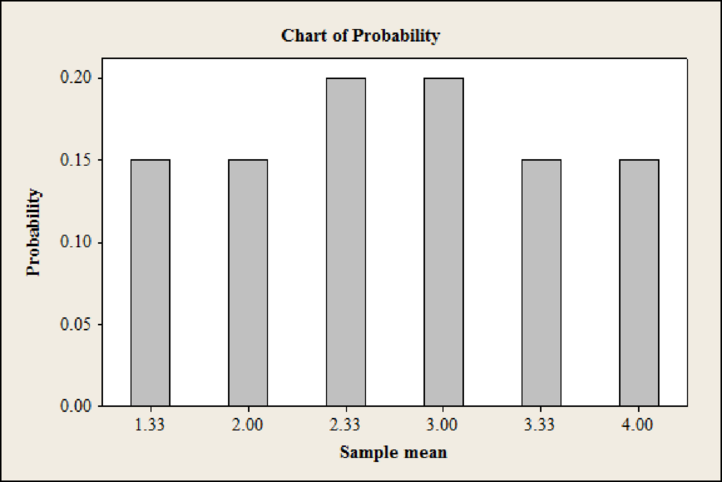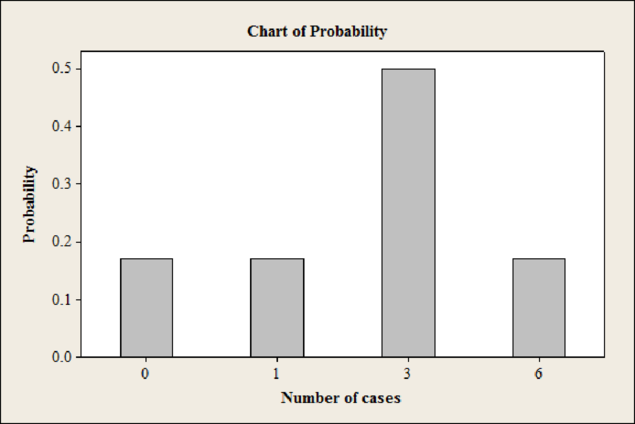
Concept explainers
a.
Find the possible number of different samples of size 3.
a.
Answer to Problem 9E
The possible number of different samples of size 3 is 20.
Explanation of Solution
From the given information, the number of cases each partner actually tried in court is 3, 6, 3, 3, 0 and 1.
The possible number of different samples of size 3 is obtained by using the following formula:
Substitute 6 for the N and 3 for the n
Then,
Thus, the possible number of different samples of size 3 is 20.
b.
Give the all possible samples of size 3.
Find the mean of each sample.
b.
Answer to Problem 9E
All possible samples of size 3 are
The mean of each sample is 4, 4, 3, 2, 2, 2, 2, 1.33, 1.33, 1.33, 4, 3, 3, 2.33, 3, 3.33, 2.33, 2.33, 2.33, 3.33 and 3.33.
Explanation of Solution
The mean is calculated by using the following formula:
| Sample | Mean |
Thus, all possible samples of size 3 are
Thus, the mean of each sample is 4, 4, 3, 2, 2, 2, 1.33, 1.33, 1.33, 4, 3, 3, 2.33, 3, 3.33, 2.33, 2.33, 2.33, 3.33 and 3.33.
c.
Compare the mean of the sample means to the population mean.
c.
Answer to Problem 9E
The mean of the distribution of the sample means is equal to the population mean.
Explanation of Solution
The mean of the sample means is calculated as follows:
Population mean is calculated as follows:
The population mean is 2.67.
Comparison:
The mean of the distribution of the sample mean is 6.8 and the population mean is 6.8. The two means are exactly same.
Thus, the mean of the distribution of the sample means is equal to the population mean.
d.
Give the comparison of the dispersion in sample means with that of the population.
d.
Answer to Problem 9E
The dispersion in the population is greater than with that of the sample mean.
Explanation of Solution
A frequency distribution for the sample means is obtained as follows:
Let
| Sample mean | f | Probability |
| 1.33 | 3 | |
| 2 | 3 | |
| 2.33 | 4 | |
| 3 | 4 | |
| 3.33 | 3 | |
| 4 | 3 | |
Software procedure:
Step-by-step procedure to obtain the bar chart using MINITAB:
- Choose Graph > Bar chart.
- Under Bars represent, enter select Values from a table.
- Under One column of values select Simple.
- Click on OK.
- Under Graph variables enter probability and under categorical variable enter sample mean.
- Click OK.
Output using MINITAB software is given below:

From the bar chart it can be observed that the shape of the distribution of the sample means is normal.
Thus, the shape of the distribution of the sample means is normal.
From the given information, the number of cases by the six partners each is 3, 6, 3, 3, 0 and 1.
| Number of cases | f | Probability |
| 0 | 1 | |
| 1 | 1 | |
| 3 | 3 | |
| 6 | 1 | |
Software procedure:
Step-by-step procedure to obtain the bar chart using MINITAB:
- Choose Graph > Bar chart.
- Under Bars represent, enter select Values from a table.
- Under One column of values select Simple.
- Click on OK.
- Under Graph variables enter probability and under categorical variable enter Number of cases.
- Click OK.
Output using MINITAB software is given below:

From the bar chart it can be observed that the shape of the population distribution is uniform.
Thus, the shape of the population distribution is uniform.
The population values are 3, 6, 3, 3, 0 and 1. From the part b, the mean of each sample is 4, 4, 3, 2, 2, 2, 1.33, 1.33, 1.33, 4, 3, 3, 2.33, 3, 3.33, 2.33, 2.33, 2.33, 3.33 and 3.33.
The population values are between 0 and 6. The sample mean values are between 1.33 and 4.
Thus, the dispersion in the population is greater than with that of the sample mean.
Want to see more full solutions like this?
Chapter 8 Solutions
EBK STATISTICAL TECHNIQUES IN BUSINESS
 Glencoe Algebra 1, Student Edition, 9780079039897...AlgebraISBN:9780079039897Author:CarterPublisher:McGraw Hill
Glencoe Algebra 1, Student Edition, 9780079039897...AlgebraISBN:9780079039897Author:CarterPublisher:McGraw Hill
